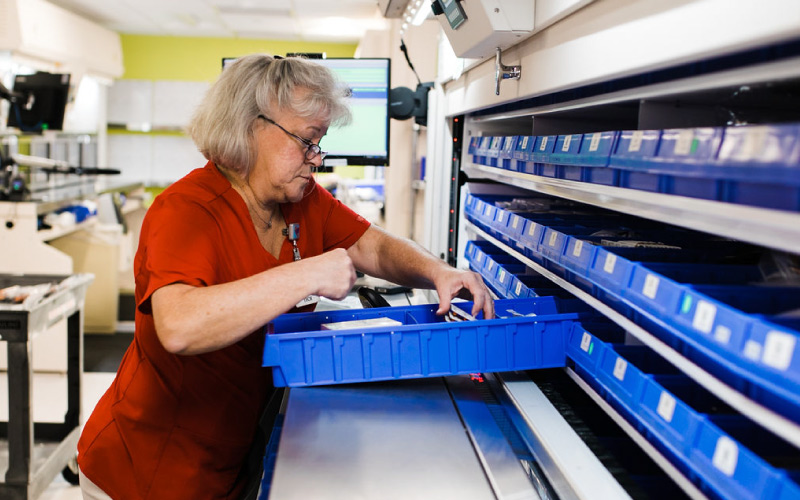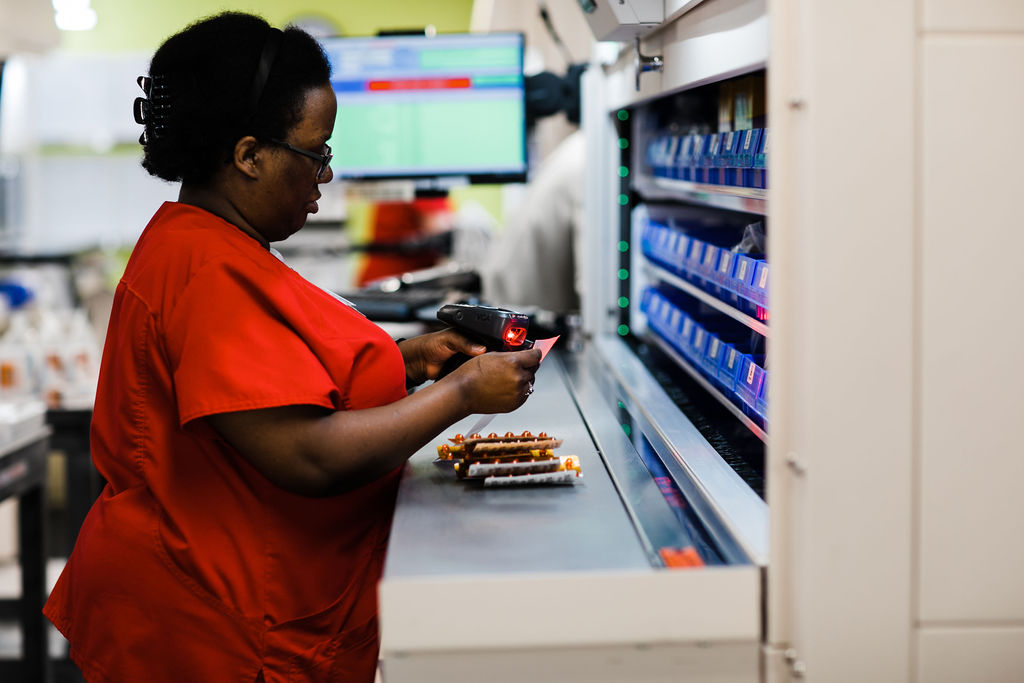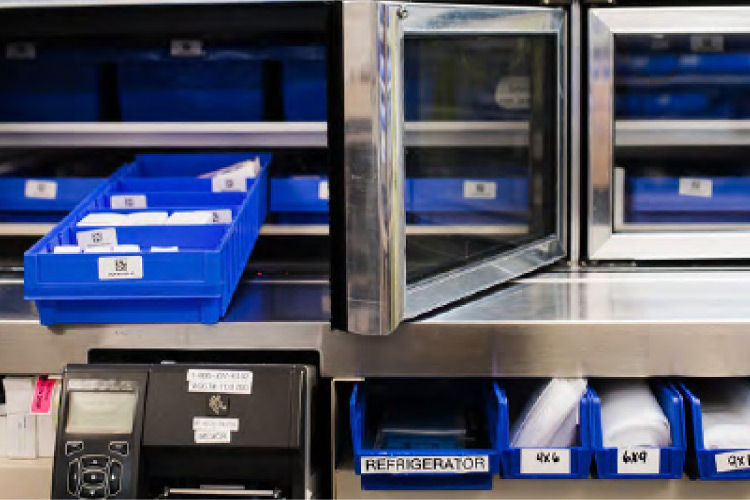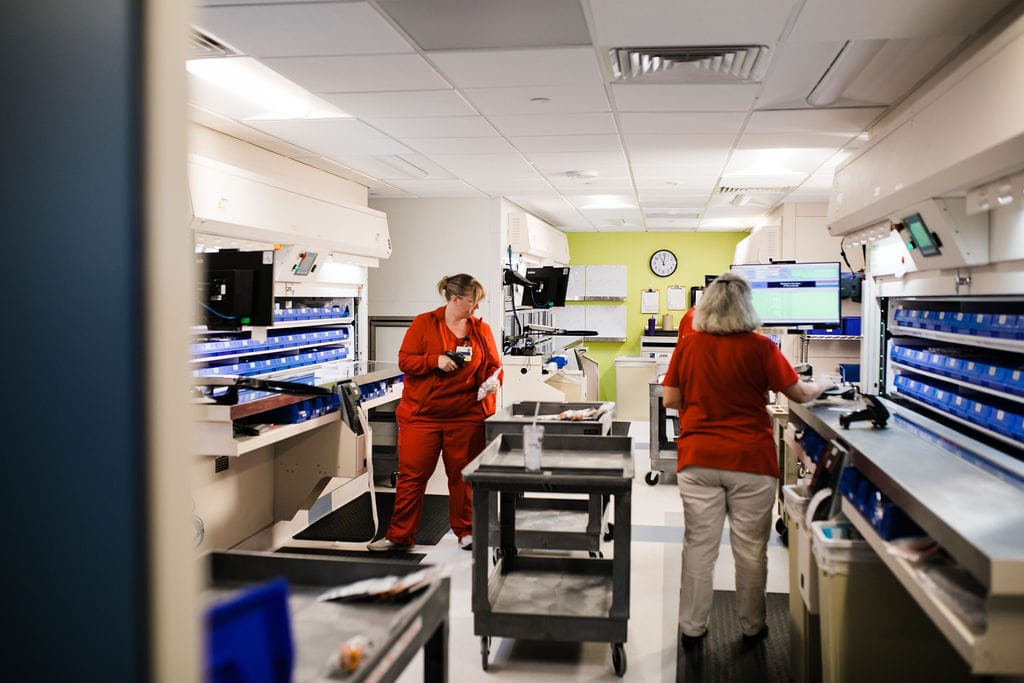A Guide to Understanding Vertical Carousels
Introduction: When Floor Space and Efficiency Collide
Many operations hit a wall—not because of demand, but because of inefficient storage. Shelving and cabinets force employees to search, bend, and climb for every item, while valuable vertical space sits unused. For facilities managing thousands of small to medium parts, those inefficiencies add up to longer lead times, higher error rates, and wasted square footage.
Vertical Carousels offer a proven, automated solution. Using a rotating chain of carriers that deliver stored items directly to an access window, vertical carousels transform slow, manual retrieval into a controlled, ergonomic, goods-to-person process.
At White Systems, our vertical carousels have been trusted for decades in hospitals, laboratories, manufacturing plants, and government facilities. We design and support every system in the U.S., with service technicians located nationwide.
1. What Is a Vertical Carousel?
A Vertical Carousel is an enclosed, motor-driven storage system built around a continuous loop of carriers that rotate vertically within a steel frame—much like a Ferris wheel for stored parts. When an operator requests an item, the carousel automatically rotates to bring the correct carrier to a waist-high access window.
This design eliminates climbing, reaching, and searching, providing a compact, secure, and user-friendly storage method ideal for high-density, repetitive access applications.
Core Technical Specifications (Typical Ranges):
-
Carrier width: up to 3,000 mm (118 in)
-
Carrier depth: 500–800 mm (20–32 in)
-
Payload per carrier: up to 750 lbs (340 kg)
-
System height: 8–30 ft (customizable)
-
Cycle time: 15–25 seconds
-
Positioning accuracy: ±1 mm
White Systems carousels use precision drives, heavy-duty chains, and digital encoders for accurate, quiet, and reliable motion.

2. How a Vertical Carousel Works

Each unit houses two parallel chains that support a series of carriers (shelves or bins). These carriers are evenly spaced and mechanically linked, so when one moves up, another moves down.
When an item is requested—via a keypad, touchscreen, barcode, or connected software—the carousel’s control system calculates the shortest rotation path and delivers the correct carrier to the access window.
Components Overview:
-
Carriers: Customizable shelves, bins, or drawers.
-
Drive System: Electric motor and dual-chain mechanism.
-
Controller: PLC-based system managing rotation and safety.
-
Operator Interface: Touchscreen or integrated software panel.
-
Safety Systems: Light curtains, access doors, and emergency stops.
Because the carriers travel vertically, operators can store and retrieve parts from a fixed ergonomic position—reducing fatigue and improving productivity.
3. Key Benefits and Performance Metrics
White Systems carousels are especially effective where small and medium parts are picked frequently and accuracy is critical.

4. Types of Vertical Carousels

Different configurations meet different operational goals.
Each configuration can be integrated with a WMS, ERP, or another software for real-time tracking and automated inventory updates.
5. Design and Sizing Considerations
When planning a carousel system, consider both the physical and operational variables that affect performance.
Key design factors:
-
Ceiling Height: Determines maximum rotation clearance and number of carriers.
-
Load Requirements: Influences carrier design and drive capacity.
-
Access Frequency: Helps define speed requirements and control configuration.
-
Item Mix: Small parts vs. boxed materials affect carrier size and divider layout.
-
Workflow Integration: Determines positioning near workstations or conveyors.
White Systems engineers can model your space and item profile to determine the best layout for throughput, ergonomics, and ROI.

6. Integration and Controls

Modern carousels are far more than mechanical storage—they’re connected, data-driven systems.
Software and Controls
-
Integrate with ERP, WMS, or MES platforms.
-
Support barcode and RFID access for traceability.
-
Enable batch picking, restock prompts, and dynamic slotting.
-
Optional connection to software for centralized dashboard control of all automated systems.
Maintenance and Diagnostics
White Systems vertical carousels are built for uptime:
-
Industrial-grade components rated for continuous duty.
-
Preventive maintenance typically required twice yearly.
-
Optional remote diagnostics via secure connection.
-
Service contracts with U.S.-based Field Service Engineers for rapid response.
7. Comparison: Vertical Carousel vs. Other Storage Systems
This comparison helps clarify that while VLMs offer greater flexibility for mixed inventory, vertical carousels are unmatched for small, repetitive storage needs where reliability and simplicity are priorities.
8. Applications Across Industries
Vertical carousels thrive in operations where speed, security, and accuracy outweigh the need for extremely tall storage.

9. Real-World Example

Case Example: Hospital Pharmacy Automation
A large hospital faced space shortages and stock management challenges in its central pharmacy. By installing three White Systems vertical carousels with barcode integration and access control, they achieved:
-
65% floor-space reduction
-
99.7% inventory accuracy
-
Faster restock and pick cycles
-
Improved technician ergonomics
Case Example: MRO Facility Upgrade
An aerospace manufacturer replaced static shelving with two White Systems industrial carousels.
-
Reclaimed 1,200 ft² of space
-
Improved part retrieval speed by 2.5×
-
Reduced pick errors to near zero
-
ROI realized in 14 months
10. The Future of Vertical Carousels
Automation continues to evolve beyond mechanical motion.
White Systems is driving innovation through:
-
Integrated analytics for predictive maintenance
-
Smart slotting algorithms that optimize carrier layout automatically
-
IoT connectivity for real-time performance data
-
Energy-efficient motors with regenerative braking
-
Enhanced safety and ergonomic features for operator well-being
These advancements keep the vertical carousel relevant in a landscape increasingly defined by lean, connected, data-driven operations.
11. Key Takeaways
-
Space Efficiency: Up to 70% reduction in storage footprint.
-
Improved Productivity: 2–3× faster picking than static shelving.
-
Ergonomic Operation: Waist-level access minimizes strain.
-
Secure and Traceable: Controlled access and audit logs.
-
Reliable and Supported: Built in the U.S. and backed by nationwide service.

12. Frequently Asked Questions

Q: How tall can a vertical carousel be?
White Systems carousels are custom-built up to 30 feet tall, depending on ceiling height and load requirements.
Q: What maintenance is required?
Regular routine preventive service is recommended. Our systems feature self-lubricating chains and easily accessible drive components.
Q: Are carousels safe for hospital or cleanroom environments?
Yes. We manufacture cleanroom and low-noise models that meet hospital and ISO standards.
Q: Can carousels integrate with our inventory software?
Absolutely. We offer open communication protocols and additional software for complete integration.
Q: What’s the typical ROI?
Most customers see payback in a series of months, depending on volume and labor savings.
Conclusion: Compact Automation with Proven Reliability
For facilities that handle high-volume, small-to-medium parts, Vertical Carousels deliver a powerful combination of space efficiency, accuracy, and reliability.
They’re simple, proven, and built to last—engineered and supported in the U.S. by White Systems, the name trusted for decades in automated storage.
If you’re ready to improve productivity and reclaim valuable floor space:
Take it With You
Download the Guide in pdf format.
